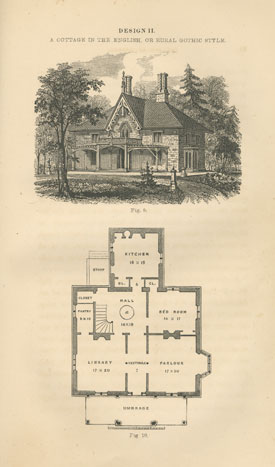| |
Gothic as Mystery and Delicious Gloom
The idea of the gothic began with 18th-century Englishman Horace Walpole, who created the concept of the romantic-gothic in his fantasy castle, Strawberry Hill, located just outside of London. Walpole’s medievally-inspired “little gothic castle” included battlements, pinnacles, a round tower, fan vaulted ceilings, and pointed gothic arches. Like today’s Goths, Walpole saw mystery in the “dark.” In designing Strawberry Hill, Walpole looked to create an otherworldly—and rather theatrical—environment through the use of mysterious shadows of dark and light. Word spread as others learned of Walpole’s unique creation and gothic elements began to find their way into stylish design—not quite medieval, but not of its time, either.
Gothic as Romantic and Picturesque
By the mid 19th century, a popular trend that came to be known as Gothic Revival emerged from Walpole’s vision. For Walpole, the gothic was a personal fantasy world. For those who embraced it decades later, it was an emotionally–infused alternative to the rational Classical design so in vogue in the early decades of the 19th century. The Classical taste was about symmetry and order. The Gothic taste was about emotion, whimsy, and the spiritual. Many Americans thought the Gothic style pretty and charming—so picturesque—and by the mid-19th century, popular American taste was all about the “picturesque.”
What constituted the Gothic Revival? The kinds of decorative elements one would find on a medieval cathedral like tall spires, pointed arches and trefoils (a stylized three-part leaf design). Where did these design elements appear? On newly-built churches, houses, stoves, furniture, glassware, silver—and even industrial machinery.
At Home with Gothic
 |
Prominent architect Andrew Jackson Downing—a big fan of the Gothic Revival—offered house designs in this picturesque style for middle-class Americans in his 1842 book, Cottage Residences. This illustration has the most self-conscious gothic elements—in the chimneys, windows, and the “gingerbread” detail in the central gable. THF.110992 |
A Heavy Dose of Gothic
Gothic Lite
Whether a vampire novel, a medieval-looking church, or furniture decorated with pointed arches, the gothic has “lurked about” American culture for a very long time. Yet it was never a truly mainstream style.
| |
-- Charles Sable, Curator of Decorative Arts |
|

